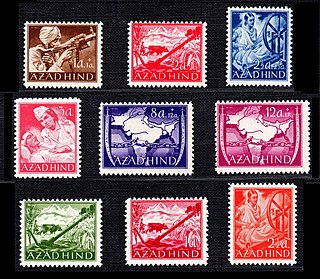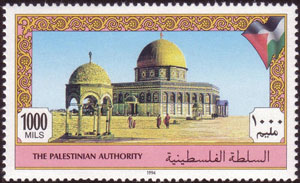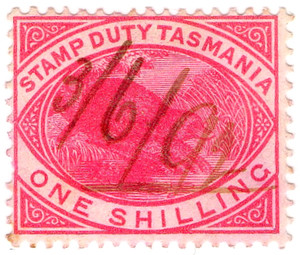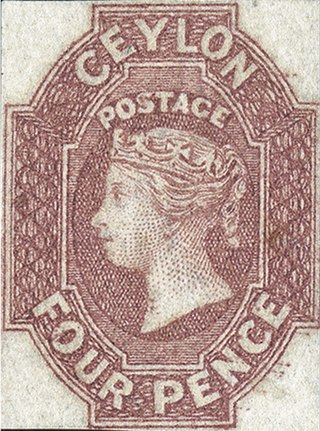
Stamp collecting is the collecting of postage stamps and related objects. It is an area of philately, which is the study of stamps. It has been one of the world's most popular hobbies since the late nineteenth century with the rapid growth of the postal service, as a stream of new stamps was produced by countries that sought to advertise their distinctiveness through their stamps.

An overprint is an additional layer of text or graphics added to the face of a postage or revenue stamp, postal stationery, banknote or ticket after it has been printed. Post offices most often use overprints for internal administrative purposes such as accounting but they are also employed in public mail. Well-recognized varieties include commemorative overprints which are produced for their public appeal and command significant interest in the field of philately.

The Penny Black was the world's first adhesive postage stamp used in a public postal system. It was first issued in the United Kingdom on 1 May 1840 but was not valid for use until 6 May. The stamp features a profile of Queen Victoria.

The postal and philatelic history of Canada concerns postage of the territories which have formed Canada. Before Canadian confederation, the colonies of British Columbia and Vancouver Island, Prince Edward Island, Nova Scotia, New Brunswick and Newfoundland issued stamps in their own names. The postal history falls into four major periods: French control (1604–1763), British control (1763–1841), colonial government control (1841–1867), and Canada, since 1867.
This is a list of philatelic topics.

This is a survey of the postage stamps and postal history of the Falkland Islands.

The Prince Consort Essay was a surface printed printer's sample stamp created in 1851 as an example of the surface printed stamps that Henry Archer proposed to print and perforate under contract with the British government at a lower price than the current printing firm of Perkins Bacon. The Prince Consort stamps were provided by the artist Robert Edward Branston, from an engraving executed by Samuel William Reynolds.

The Department of Posts, functioning under the brand name Sri Lanka Post, is a government operated postal system in Sri Lanka. The postal headquarters is the General Post Office which is located in Colombo. The department itself comes under the purview of the Ministry of Information and Mass Media. It was formerly known as the Ceylon Post and Telecommunications Department and is one of the oldest Government departments in existence today.

The Azad Hind stamps are a set of prepared but never issued stamps for the planned Provisional Government of Free India under Subhas Chandra Bose. All stamps were printed by photogravure in sheets of 100 at the Reichsdruckerei, the Government Printing Bureau in Berlin.

Postage stamps of Pakistan are those issued since Pakistan's independence in 1947. Pakistan Post has issued more than 600 sets and singles totalling more than 1300 stamps. Immediately after the independence of Pakistan in 1947, the new Pakistan government was preoccupied with setting up the government so British Indian stamps continued in use without an overprint as was the practice in other countries.

The Palestinian National Authority began in 1994 to issue stamps and operate postal services as authorized by the Oslo Accords.
Between 1851 and 1860, the Grand Duchy of Tuscany, an independent Italian state until 1859 when it joined the United Provinces of Central Italy, produced two postage stamp issues which are among the most prized classic stamp issues of the world, and include the most valuable Italian stamp.

This is a survey of the postage stamps and postal history of Cape of Good Hope.

This is a survey of the postage stamps and postal history of Natal. Natal was proclaimed a British colony on 4 May 1843 after the British had annexed the Boer Republic of Natalia.

The Australian state of Tasmania issued adhesive revenue stamps from 1863 to 1998, although impressed stamps had appeared briefly in the 1820s. There were general revenue and stamp duty issues, as well as a number of specific issues for various taxes.

Nyasaland, now known as Malawi, first issued revenue stamps as British Central Africa in 1891 and continued to do so until the late 1980s.

Stamps of the Soviet Union were issued in the period 1923 to 1991. They were labeled with the inscription Russian: "Почта СССР". In the thematics, Soviet stamps reflected to a large extent the history, politics, economics and culture of this world's first socialist state.

The Dull Rose is a Ceylonese postage stamp that is considered to be the rarest and most valuable stamp issued in the country. 7000 stamps were issued on 23 April 1859, bearing a face value of four pence. Three others, the 8 pence, 1 shilling & 9 pence (green), and 2 shilling & 9 pence were issued on the same date as part of a series. These featured a left-facing depiction of a young Queen Victoria in an octagonal framing.

The Black Swan is the first postage stamp issued by the British colony of Western Australia in 1854. It illustrates a black swan, a typical Australian animal at the time and was the only image used on Western Australian stamps until 1902.




















